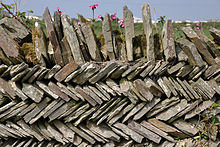- Cornish hedge
-
 Country lane in St Newlyn East
Country lane in St Newlyn East
A Cornish hedge is a style of hedge built of stone and earth found in Cornwall, south-west England. Sometimes hedging plants or trees are planted on the hedge to increase its windbreaking height. A rich flora develops over the lifespan of a Cornish hedge. The Cornish hedge contributes to the distinctive field-pattern of the Cornish landscape, and form the county's largest semi-natural wildlife habitat.
Contents
Construction
“ A Cornish hedge has two sides which are built by placing huge stone blocks into the earth and packing them in with sub-soil. Smaller interlocking rocks are used to build the hedge high until it reaches a level when random turns into neat rows of square stones called "edgers". Two inches of grass are sliced from the ground and stuck on top of the structure with sticks.
” —Article in The West Briton[1]
History
 Hedge built of local slate at Tintagel
Hedge built of local slate at Tintagel
There are about 30,000 miles (48,000 km) of hedges in Cornwall today,[citation needed] and their development over the centuries is preserved in their structure. The first Cornish hedges enclosed land for cereal crops during the Neolithic Age (4000–6000 years ago). Prehistoric farms were of about 5 to 10 hectares (12 to 25 acres), with fields about 0.1 hectares (0.25 acre) for hand cultivation. Some hedges date from the Bronze and Iron Ages, 2000–4000 years ago, when Cornwall's traditional pattern of landscape became established. Others were built during the Mediaeval field rationalisations; more originated in the tin and copper industrial boom of the 18th and 19th centuries, when heaths and uplands were enclosed.[2]
In other parts of Britain, early hedges were destroyed to make way for the manorial open-field system. Many were replaced after the Enclosure Acts, then removed again during modern agricultural intensification, and now some are being replanted for wildlife. Cornwall is richer in historic hedges than other parts of Britain, with over three-quarters of the hedges remaining today being anciently established.[citation needed]
The Cornish Hedge Research and Education Group (CHREG) is the main body promoting the understanding of Cornish hedges in Cornwall. It is currently a partner in a Transeuropean project to share the knowledge of traditional skills related to hedges and drystone buildings.
The materials used for the hedge vary in different parts of the county because of the underlying rocks. Building methods with slate are different from those with granite since the sides of each stone are relatively flat. In building with slate if the stones are small they will be laid "cursy-wavy" or herringbone fashion each course being inclined either to right or left alternately. There would be a foundation of larger stones and a row of coping stones (larger than the rest) standing on edge to complete the top.
Maintenance
Cornish hedges suffer from the effects of tree roots, burrowing rabbits, rain, wind, farm animals and people. Eventually the hedge sides lose their batter, bulge outwards and stones fall. How often repairs are needed depends on how well the hedge was built, its stone, and what has happened to it since it was last repaired. Typically a hedge needs a cycle of repair every 150 years or so, or less often if it is fenced. Building new hedges, and repairing existing hedges, is a skilled craft, and there are professional hedgers in Cornwall. The Cornish Hedge Research and Education Group (CHREG) supports the development of traditional skills and works with Cornwall County Council, Fwag (Farming and Wildlife Advisory Group), Stone Academy Bodmin, Cornwall AONB, Country Trust and professional hedgers to ensure the future of Cornish Hedges in the landscape.
See also
References
- ^ "New course will try to save traditional Cornish Skill". The West Briton Falmouth edition: 24. 2007-05-10.
- ^ Cornish hedges website, including history and links
Further reading
- Balchin, W. G. V. (1954) Cornwall: an illustrated essay on the history of the landscape; chap. 4. London: Hodder and Stoughton
External links
 Media related to Cornish hedges at Wikimedia CommonsCategories:
Media related to Cornish hedges at Wikimedia CommonsCategories:- Buildings and structures in Cornwall
- Agriculture in England
- Fences
- Walls
- Garden features
- Environment of Cornwall
Wikimedia Foundation. 2010.

